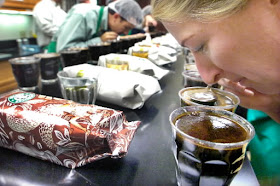
 Starbucks use an attribute control system, which is the measurement based on the quality characteristic on a discrete scale meaning the item is good or defective. This is where percentages are used for the amount of defects. To calculate they take a sample of units at random from a process at specified intervals and the results are plotted on the p control chart. To calculate the center line and control limits of the p chart they take a large number of samples and the percent defected is calculated for all samples to give a true average.
Starbucks use an attribute control system, which is the measurement based on the quality characteristic on a discrete scale meaning the item is good or defective. This is where percentages are used for the amount of defects. To calculate they take a sample of units at random from a process at specified intervals and the results are plotted on the p control chart. To calculate the center line and control limits of the p chart they take a large number of samples and the percent defected is calculated for all samples to give a true average. Continuous Improvement is said to be undertaken if the process capability is not adequate to meet present or future needs. Articles from both the Wall Street Journal and CBS News confirm that Starbucks implements continuous improvement however we could not find information of the specific diagrams used.

Lean systems have the objective if eliminating waste defined as non-value-adding activities. Six sigma on the other hand are aimed at reducing defects as seen by the customer. Recently many companies have started combining Lean and Six Sigma practices and Starbucks is one of them. In a Wall Street Journal article Starbucks is described as utilizing a combination of lean and six sigma is practiced. According to a branch manager at one of the locations “It does not make any sense to waste people’s time, energy and resources in doing unnecessary things at the workplace.” Examples of this includes placing equipment and ingredients where they are needed, using one expresso machine and washing pitchers after every use.
Recommendations
The aforementioned articles discussed how Starbucks has high quality control but also highlighted a negative impact due to that which was poor time management. The baristas were responsible for conducting the quality checks such as heating milk for each individual order, rinsing pitchers after each use and stocking ingredients. Though this increased quality, customers were becoming disgruntled as they had to incur long lines and longer wait times. Our group recommends that Starbucks should find a way to maintain its quality control methods but improve its time management. One such way is by having another employee be responsible for the quality checks so baristas could focus on coffee production which should reduce the actual order time and higher customer satisfactiom.


